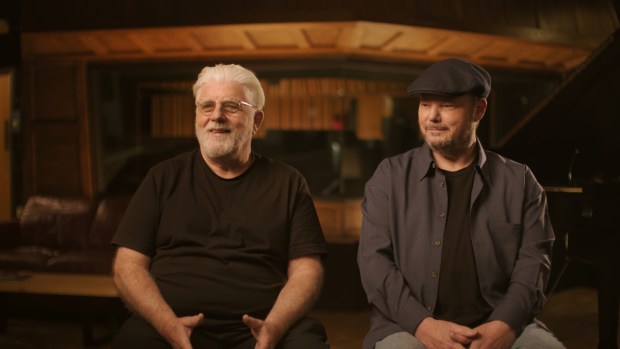“The Doobie Brothers were a kickass rock and roll band, then Michael McDonald rolled in with his easy listening voice and ruined everything.”
That comment appears on a community page for guitar aficionados. For decades, it was the prevailing sentiment in pop culture, which had firmly moved on from soft rock. Then in 2005, something unlikely happened. A comedic web series about the fictionalized highs and lows of McDonald (and his pop musical peers from the late 1970s and early ’80s) gave the music a name: yacht rock.
HBO’s “Yacht Rock: The Documentary” isn’t about that low-rent, intentionally amateur-looking web series (with its absurdly funny origin story for the 1978 single “What a Fool Believes”), but its creators are featured prominently, thanks to their thoroughly unironic and thoughtful appreciation for the music itself.
The taxonomy of yacht rock, which spans 1976-1984, includes McDonald (with and without The Doobie Brothers), Steely Dan and Kenny Loggins, it’s music defined by “jazz chord changes but rock and pop grooves,” which is how one person describes it. Someone else calls it “elevated pop music that’s infused with jazz and R&B.” Here’s how session guitarist Jay Graydon puts it: “We’re closet jazzers that are making pop records.”
For me, there are two defining features that are the key to yacht rock’s appeal: The music is melodic and full of harmonies, and a piano is always prominent. Soft rock was never the right description, though. “Soft” implies insubstantial. But the music goes hard in it’s own way, and maybe what it really needed was the kind of rebrand that “yacht rock” provided.
Let’s go back to The Doobie Brothers for a moment. According to rock critic Steven Hyden, who’s interviewed here, “If you want a microcosm of how mainstream rock music changed from the beginning of the ’70s to the end of the ’70s, The Doobie Brothers are probably the best place to go.” Originally a “post-Woodstock, good-time boogie band that bikers listened to in bars,” by the end of the decade they evolved into “this jazzy pop R&B band that is using a lot of chords and playing songs in tricky time signatures. It’s a big, big change.”
JD Ryznar, creator of the “Yacht Rock” web series, recalls how he came up with the genre’s moniker. The album cover for the 1973 album “Full Sail” features the duo of Kenny Loggins and Jim Messina under sunny skies on a sailboat. They look carefree and unbothered. Maybe that planted the initial idea. But Ryznar was also thinking about the vibe. “This is well-crafted stuff. This is relaxing stuff. It’s high-class stuff. It’s like a yacht. Yacht rock.”
Directed by Garret Price, the film is a better stripe of this kind of documentary than typical, and one of its strengths is the way it delves into the creative process. Yes, tell us how some of these songs came together! There isn’t an abundance of pointless celebrity interviews that add nothing. And session musicians are given their due. I hadn’t realized, for example, that Toto was made up of session musicians, such as guitarist Steve Lukather, who often played on other people’s albums during this period.
When they were called in for a gig, “Sometimes we knew the artist, sometimes we didn’t,” Lukather says. “Every day was a thrill because we didn’t know what we were going to do. There were no demos, there were no rehearsals. Most of the time we listened to the song once and all of us have ‘arranger ears,’ and that just means we can hear parts in between the basic chords and the melody. And that’s what they hired us to do, to fill in the blanks, because we were good at it.”
I think for some listeners, soft rock suggests a softer (or cleaner) side of the music world, but that’s not really true. Christopher Cross financed his demos by selling weed and wrote “Ride Like the Wind” while on acid during a road trip from Houston to Austin. McDonald sings a backing vocal on the track, because of course he does. There’s a famous “SCTV” parody featuring Rick Moranis as McDonald, running himself ragged providing vocals to everyone in town, and the real McDonald tells Price a story about seeing that for the first time when he was high. “I thought I was hallucinating.”
“One way to know if you are listening to yacht rock is if you hear the sound of Michael McDonald’s voice,” someone says. “He is such an important sonic element to so many of these records.” It’s a distinctive voice. Questlove describes it as a “really comforting voice akin to a really funky muppet.”
But fundamentally the film succeeds because the musicians themselves are good storytellers. “What a Fool Believes” was co-written by McDonald and Loggins, the latter of whom calls it “the quintessential yacht rock song of the era, for some reason. Still trying to figure that out.”
It won a song of the year Grammy in 1980, and then the pair avoided one another, wary of a sophomore jinx. A year later, Loggins recalls telling McDonald, “‘We gotta get together and write a second song. So let’s just write a (crappy) song and get that out of the way and do that thing that we’re afraid of.’ So the (crappy) song that we wrote was ‘This Is It,’ which won a Grammy the next year.” When you’re riding high, you’re riding high.

It wouldn’t last. “Artists run out of hits,” someone says. “The zeitgeist moves on without you. The fact is, Top 40 careers have a natural end. They always do and always will.”
The introduction of MTV was a factor, scrambling all the old ideas about what it meant — and looked like — to be a rock star. Everything became more reliant on the visuals. “You have bands that want to play along with this and bands that don’t,” someone notes.
The musicians here are white. But they’re clear about their influences: Black artists, including Stevie Wonder; Earth, Wind & Fire; The Crusaders and Herbie Hancock. It’s a tale as old as time: Behind so much great white music is the story of Black music. But the conversation could go both ways; the members of Toto played on Michael Jackson’s “Thriller,” with the band’s keyboardist Steve Porcaro writing “Human Nature.”
Years later, so many of yacht rock’s indelible riffs were given new life when they became hip-hop samples on tracks like Warren G’s “Regulate,” which borrows from the 1982 McDonald hit “I Keep Forgettin’ (Every Time You’re Near).” And of course, there’s now an entire cottage industry of cover bands specifically invoking boat imagery for their yacht rock lineup.
It was emo before emo, now served with a retro-metaphorical fruity cocktail. “It’s men talking about their mistakes,” Ryzna says. “It’s men talking about how sad they are about their breakups. And there’s always been music like that, but there’s something about yacht rock where men embrace being the sad sack loser in a really big way.”
“Yacht Rock: A Documentary” — 3 stars (out of 4)
Where to watch: Max
Nina Metz is a Tribune critic.



